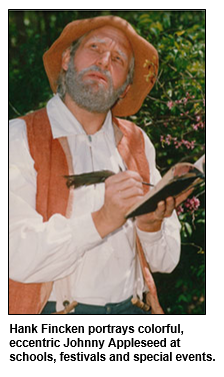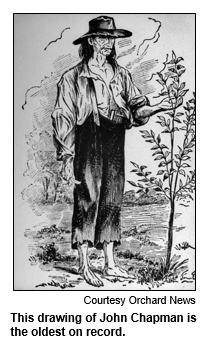|
Saturdays, noon to 1 p.m. ET on WICR 88.7 FM. |
|||||||||||
May 20, 2017 show From our audio archives: Two encore showsSome people like to plant things; others like to dig them up. This week, Hoosier History Live presents two 30-minute encore shows from our rich audio archives focusing on two memorable figures from Indiana history. The first show explores the life of errant Hoosier tree-planter John Chapman, aka Johnny Appleseed. The second investigates the disinterment of corpses for the purpose of selling them to medical schools in the early 1900s, as practiced by Indianapolis grave robber Rufus Cantrell. Johnny Appleseed: The facts and myths
To enlighten us, one of the country's foremost experts on Johnny Appleseed joins Nelson in studio. His guest is Indianapolis-based re-enactor and playwright Hank Fincken, who has spent decades researching Appleseed/Chapman. Hank portrays colorful, eccentric Johnny Appleseed at schools, festivals and special events. According to most accounts, John Chapman was born in New England in 1774. He was a pacifist and a vegetarian who befriended many Native Americans - all cause for many other pioneers to regard him as a bit of an oddball, although they were grateful for his gifts of apple seedlings as they settled in the frontier. The wanderlust of Chapman/Appleseed is said to have been motivated in part by his spiritual beliefs. In addition to apple seedlings, he distributed scriptures across the Indiana wilderness in the 1830s and '40s.
You can judge for yourself as Hank portrays a bit of his Appleseed character during the show. Some fun facts:
Grave robbers of the early 1900s in Indianapolis(Originally aired on March 3, 2008) Some people called them "resurrections." Grave robbers outraged people across the country more than 100 years ago; one of the most notorious was based in Indianapolis.
According to Joan, Cantrell and his large crew (often billed as "Cantrell and His Gang of Ghouls" by Hoosier newspapers) specialized in stealing bodies from small, rural cemeteries in the Indianapolis area. (They never robbed a grave at Crown Hill Cemetery, the city’s largest cemetery.) There's some thought that Cantrell and his gang befriended grave diggers, enlisting them in their scheme. The gang sold corpses to medical schools and physicians in four states. Among Cantrell's most shocking crimes: After presiding as a preacher at his niece's funeral, Cantrell later slipped into the cemetery and unearthed her corpse. His eventual capture and trial generated national headlines.
As refrigeration developed in the early 1900s and medical schools could keep bodies intact for later dissection and examination, the demand by medical schools for "fresh" bodies from the black market became obsolete. Joan, who collaborated with Nelson and photographer Garry Chilluffo on the Indianapolis Then and Now visual history book, stumbled upon Cantrell's story while researching the life of a detective who helped put the grave robber behind bars. By the way, you can listen to one of Joan's favorite songs pertaining to this grisly topic, "The Resurrectionist" by the Pet Shop Boys. Learn more:
Your Hoosier History Live team, Nelson Price, host and creative director Please tell our sponsors that you appreciate their support: Indiana Historical Society | Indiana Landmarks | Lucas Oil | MBP Catering | Story Inn | English Ivy's
Thank you!We'd like to thank the following recent, new and renewal contributors whose donations help make this show possible!
© 2017 Hoosier History Live. All rights reserved. | |||||||||||
|

 (Originally aired on Nov. 14, 2009) His real name was
(Originally aired on Nov. 14, 2009) His real name was  Before that, Chapman was a true hero during the War of 1812 and helped save the lives of massacre survivors trapped in
Before that, Chapman was a true hero during the War of 1812 and helped save the lives of massacre survivors trapped in  Rufus Cantrell
Rufus Cantrell Grave robbing
Grave robbing






